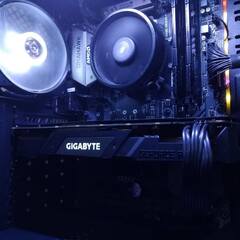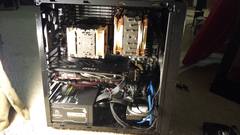-
Posts
93 -
Joined
-
Last visited
Content Type
Forums
Status Updates
Blogs
Events
Gallery
Downloads
Store Home
Everything posted by Bloody-George
-
You can usually find it on the manufacturer's website, or on techpowerup. You have to look up the specific model of your GPU (if it's Extreme Edition, Gaming OC, that kind of thing). Try googling it, and if still you can't find yours, contact Gigabyte requesting a BIOS fix for your model.
-
Oh my. So I think your fans may actually be dead. Two questions: 1. When you write "Otherwise gpu works fine i can do everything except play some demanding games," what exactly happens when you play these demanding games? 2. Have you tried reinstalling Geforce Experience and the GPU drivers? Unlikely to help, but still worth a try. The only other thing I can think about is a GPU BIOS fix or update.
-
If you have disassembled the graphics card to clean it more thoroughly, there's a chance you haven't reconnected the fans or have reconnected them in a wrong way. Take a look inside again. Edit: And to answer one of your first questions, no; the problem is likely not related to the GPU itself.
-

WD Black SN750 vs. Corsair MP510 (500GB SSD choice)
Bloody-George replied to Bloody-George's topic in Storage Devices
Nice! Thank you so much for the answer! I'll get it then. -
Hi everyone! I'm looking for a nicely priced but relatively fast 500GB NVMe SSD to put in my rig, and two choices have dropped in price here in my country: the Western Digital Black SN750 (no-heatsink version) and the Corsair Force Series MP510. Right now, they are similarly priced, although the WD model is a tad cheaper. I have to admit, I'm not very knowledgeable when it comes to SSD read and write speeds, and what the reliable options are on the market. I've already read reviews on both of them, but to be honest, they sound like two good enough choices. I'd like to know your opinions on the two, and - if you've got one of them - what your experiences with either one or both have been before I can go ahead and make a decision. Cheers!
-
Best bang for your buck is the 3600, for sure. If you go with Intel (in your case, the 9600k), it's not worth it to get a B360 motherboard because you won't be able to overclock the CPU. And if you don't overclock it, then there's no point in getting a 9600k in the first place. The 9400F would be the option below it, and I just don't think it's as good an option as the AMD offerings, all things considered. It has such a low base clock, it's not overclockable, no hyperthreading, and it costs practically as much as the 3600 - which has SMT - aka AMD's hyperthreading -, faster speed, and is overclockable with chipsets as accessible as the B450 motherboards. TLDR: Choosing a 9600k means you'd want to overclock it, and you can't with a B360 motherboard. A 3600 offers a more accessible platform, cheaper pricing, and more CPU threads for less. In my opinion, the 3600 is your sweet spot. Obviously, it depends on what you usually do with your PC. P.S.: Oh, and as for your question about GPU/PSU compatibility, that shouldn't be a problem. The CX550M is a capable unit, and the 1660Ti is a pretty low-power-consumption card. You're good to go even if you get an i7 CPU.
-
Second option, but I advise you not to go with the 3600x. Gain in performance when compared to the 3600 is close to none, and the 3600 is cheaper. You'll save even more if you get the non-x Ryzen 5 3600. Oh, and make sure you get a motherboard that comes with updated BIOS from the shop to accomodate 3rd-gen Ryzen or that you already have an older Ryzen chip so you can update it yourself. Older AM4 mobos won't support new Ryzen chips unless you have updated BIOS. I think the B450M Bazooka Plus has the BIOS flashback feature that allows you to update it without the need of a CPU, only ATX power and a USB flash drive with the BIOS version in it.
-
Nice to hear that! Issues with electronics sometimes come and go in those strange, unknown ways. Once in a while, connectivity in some ports is a bit iffy but comes back to normal. It's good to know that the problem you had was one of those.
-
First of all, where do you live? Depending on the country, some PSU deals are better than others. In general, that's a pretty light build. 500ishW power supplies will handle your rig very well, provided they are decent units. Corsair PSUs are known to be trustworthy, durable and accessible for the regular user. I guess you want to save money and get the best part you can at the same time, so a CX550M would be good for you (semi-modular or modular power supplies are great because you get rid of stressful cable management issues). No secret when choosing a unit for a light build like yours. Go with trusted brands (Seasonic, Corsair, Silverstone...), 80-plus bronze at least, 500W capacity, and you'll be good to go. ATX means the standard size of most cases/motherboards/PSUs. If a vendor has an unusual form factor, you'll notice it by its nomenclature (micro ATX or mini ITX are the most popular low-profile standards nowadays). 90% of power supplies you find on the market are ATX.
-
If you can get another monitor/TV to test your VGA on, that'd be good as well. Check with a friend or family member; I think you can easily find a display that has an HDMI input.
-
Please do tell us how things turned out in the end. I hope you can recover as many parts as possible.
-
This. CPU is probably dead, and motherboard too. Graphics card and hard drives usually survive, but sadly core components like processor and mobo are the first ones to go.
-
I've never seen anything like this, but it definitely sounds like a PSU problem. Was some sort of electric surge or oscillation going on where you live while you turned the PC on? Are all the cables from the PSU to your components plugged in correctly? Is the power coming from the wall stable (that is, do you ever hear buzzing noises coming from your power supply or from the outlet on the wall?)? If you are too curious and want to test things safely, disconnect all PSU cables from your components and try this test with the 24-pin cable and a paper clip (follow the steps in the video closely). If the power supply fan spins, it's probably working. But, if I'm being honest, and from what you told us, the CPU - and possibly other components - is dead. It may not be the case, but this is such an anomaly as to indicate so. I'm sorry.
-
Yes, that's what I meant. Modern graphics cards usually have only one HDMI input. Try those actions first and come back with results. Stress your GPU - with gaming or Furmark - to see if the pattern continues.
-
A few questions: does that happen only when you're gaming? Have you monitored your GPU temperatures while under load? Are you overclocking your graphics card? I assume your VGA only has one HDMI input, but if it has more, try switching inputs in it too. Also, try using a different HDMI cable or another input type (DVI or Displayport) if your TV supports any of them. If that doesn't change the situation, try removing and reinserting your graphics card in the motherboard PCI-e slot. In addition, run a stress test application like Furmark to see how your graphics card behaves under sustained load and if it does the same thing then.
-
-
My current Ryzen+Turing rig. Still under construction. Specs are: Ryzen 5 3600 Gigabyte RTX 2060 Gaming OC Pro 16GB HyperX Fury RAM MSI B450 Tomahawk Corsair CX550M Kingston A400 480GB SSD Seagate Barracuda 1TB HDD Aerocool Cylon
-

Confused on my 2700x workstation build
Bloody-George replied to Kalby's topic in CPUs, Motherboards, and Memory
I think he actually said he doesn't want SLI, so B350/B450 motherboards would be good enough for him. -

Confused on my 2700x workstation build
Bloody-George replied to Kalby's topic in CPUs, Motherboards, and Memory
The difference in CPU performance between a B450 and an x370/x470 platform is minimal, especially in stock settings. You'll likely not notice it in your daily tasks. Go for the best B450 motherboard you can buy at the moment. If you won't overclock it, then top-drawer VRMs are also not that important for you. The 2700x can get pretty hot, though; so focus on nice aftermarket cooling solutions and a case with appropriate airflow. Good B450 motherboards support 3000Mhz memory (and even higher), so that's also not a concern. For 2nd-gen Ryzen, 3000Mhz upwards is the ideal frequency for optimal performance. The higher, the better. -
What software do you use to control the fan LEDs? If you connected your fans to the motherboard, it's possible that you can control the lights using Gigabyte's RGB Fusion 2.0; however, Corsair also has a software of their own - called iCUE - to control LEDs for certain components. Make sure you have both installed to control the different lights of your PC separately, and also make sure they're not conflicting with each other.
-

Windows 10 won't boot, only boots after reset.
Bloody-George replied to Bloody-George's topic in Troubleshooting
I see. Well, I do have a mechanical hard drive and the OS in it works fine with my system. The thing is that the SSD previously worked well with my i5 6600k system; the problems only started when I installed the Ryzen 5 3600 and the B450 mobo. What about updating the SSD's firmware? Do you think that could work?


















